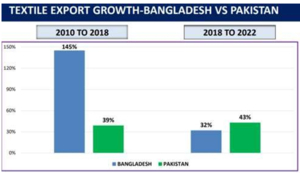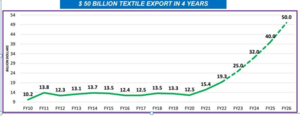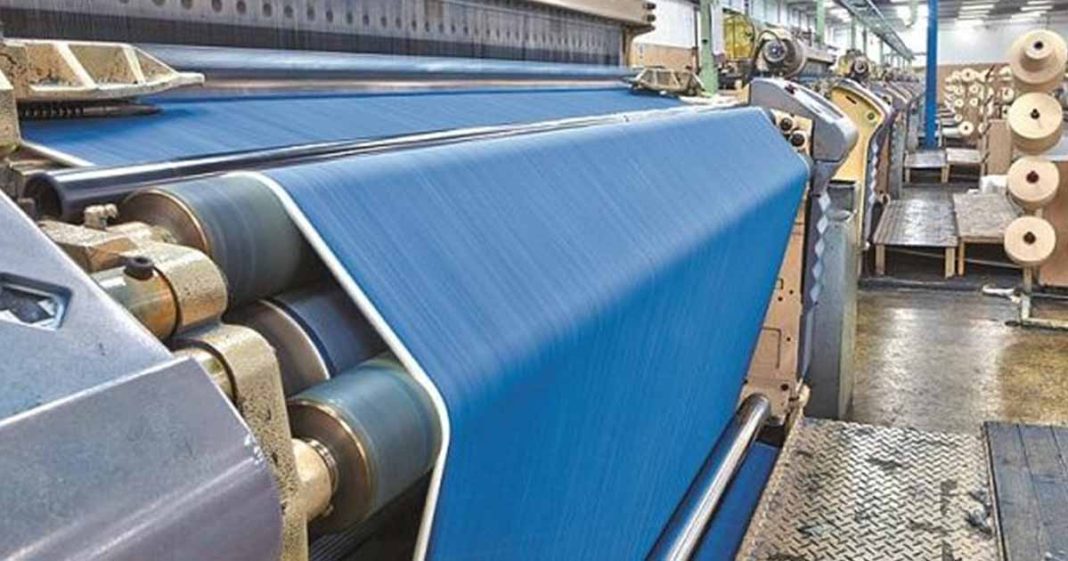Pakistan’s textile industry is on an upward trajectory with the addition of $500 million per month through incremental capacity. This has been enabled through TERF and its support of 100 new projects. However, even the current capacity is not been fully utilized due to energy supply and quality constraints for the last 6 months, costing Pakistan approximately $300 in lost production/exports million per month.
The global apparel market is expected to grow to $843.13 billion in 2026 at a compound annual growth rate (CAGR) of 8.6%, but Pakistan’s textile industry has not captured a sufficient level of this demand, given its potential and existing capacity to add $10 billion per annum to exports. The textile industry is faced with countless opportunities to capture greater market share, but state reforms in energy, technological upgradation, diversification and value addition will be necessary in order to enhance the potential of the sector and facilitate economic growth at unprecedented levels. It is pertinent to note Pakistani exporters’ exemplary handling of disruptions such as the COVID-19 pandemic and its greater performance compared to regional competitor Bangladesh.
Read more: 400 textile mills facing shutdown

To maintain the current momentum, the textile sector has committed to unprecedented value addition by committing to setting up 1000 garment plants. Each plant will consist of 500 stitching machines at an investment of $7 million; able to produce garments for exports of $20 million per annum, while generating employment for 700 workers. The total investment would be the US $7 billion generating annual exports of $20 billion and providing employment to well over 700,000 workers. A thousand garment plants are being established near major textile-producing cities.
This commitment is reliant upon strong and sustained policy support
Despite having been acknowledged as the backbone of the economy since early on, the textile sector has suffered through a period of weak policy support over the years. In order to grow at scale and achieve its target of $50 billion in exports over the next 4 years, the textile sector requires:
- An adequate supply of energy at regionally competitive tariffs
- Availability of working capital
- 500 new entrepreneurs
- TERF-like facility for Rs 500 billion ($ 2 billion) to facilitate
- Debt Equity ratio of 80:20 which includes building & infrastructure as 50 % of the cost of garment factories is on these
It is important to note that the textile sector has had its order books full for the past few years, despite the countless setbacks due to external challenges – inflation, high-interest rates, the war in Ukraine, lockdowns and technological change. By identifying key setbacks and garnering policy support and facilitation from the government at unprecedented levels, the sector emerged successful in meeting a majority of the demand, increasing its output and improving its logistics network. These results have been tangible and had a great bearing on the economic growth projection for the coming year.

The ready-made garments industry has emerged as one of the most important small-scale industries in Pakistan, with sizeable demand both at home and abroad. In terms of quality, Pakistan’s products can greatly benefit from technological upgradation. Advancements in equipment and e-manufacturing can exponentially improve our exports and facilitate an entry into high-performance apparel and MMF. This will also allow the sector to meet its needs in terms of value addition and diversification of the export bundle.
Pakistan is the 4th largest producer and 3rd largest consumer of cotton worldwide. However, this major sector is faced with frequent hurdles such as import restrictions on critical inputs, and long delays in the approval of import permits. Meanwhile, most South Asian economies have optimized their production of goods and services in which they have a competitive advantage, and further diversified their export baskets to enter an abundance of untapped markets.
Read more: Textile sector’s gas suspension to cause $1B loss: APTMA
They have also tapped into high-tech, high-value-added products. The demand for MMF-based apparel has grown exponentially, owing to the convenience it affords. However, cotton and textiles in Pakistan suffer from a lack of quality research and application. We must reduce the focus on primary commodities, and make the much overdue shift towards secondary and tertiary sectors manufactured, nontraditional goods and value-added services.
With that said, the textile sector is highly sensitive to energy outages and quality, so given Pakistan’s troubled energy sector, these matters ballooned into a large-scale hindrance in its growth and made it difficult to meet costs, let alone achieve much-needed revenue targets that could allow for modernization and expansion. A long-term Energy Tariff Policy with a clear billing mechanism is an essential component to be ensured moving forward so that the performance of the textile sector can be rid of the problems created by an unstable and uncompetitive energy supply.
In addition to this, issues of grid-connected electricity, quality, transmission and availability, and an expensive energy mix abound. The exporting industry cannot pass on incidentals of taxation & institutional inefficiencies to international buyers. 5-7% of incidences of various local provincials & Federal Taxes are not zero rated on exports. The rising circular debt is a direct result of the non-resolution of these long-standing issues.
More specific issues to be addressed include working capital requirements
In FY22, the total amount retained by FBR as sales tax on domestic sales was Rs 50 billion out of Rs 249 billion collected. Over Rs 250 billion liquidity of the industry remains with the FBR at all times as a result of this collection and refund mechanism. Sales tax is on a consumption basis which inflates inventory and capital costs, serving as an impediment to new projects as capital cost increases by 20 percent and refund can only happen after commercial operations. Furthermore, there are numerous technical errors and inefficiencies in the sales tax refund FASTER system of FBR that require immediate rectification.
Read more: Textile factories starting to close as they stop receiving gas
According to a report by the IMF, the cascading effect of GST has harmed Pakistani exporters’ competitiveness as there is currently no systemic method to ensure that all tax paid on inputs may be charged against a final sale is refunded. In this huge cycle of sales tax collection and refunds, exporters suffer in the form of delayed pending and deferred refunds. The cost of collecting and refunding sales tax outweighs the revenue collected by a significant margin.
Competing textile economies have opened up their markets, thereby securing major market shares. Following this strategy, Pakistan must formulate its trade policies with a view to increasing market access, on a reciprocal basis whereby Pakistan’s market openness would also have to increase. There must be a dedicated effort to promote private investment in the industry, which is naturally contingent upon interest rate support, as well as a reputation for never compromising on quality.
Export-oriented industries in Pakistan are at least 25 percent more productive than non-export-oriented businesses, and their productivity increases with an increase in economic activity as well as greater foreign exposure and alliances. However, systemic inefficiencies cannot be exported, so these must be mitigated from all inputs before results can be seen. Since exports in Pakistan are labor-intensive, expansion in this industry is a surefire way to ensure large-scale job creation, as well as an increase in foreign currency to pay for required imports.
Read more: APTMA urges government to continue RCETs for entire textile value chain
The problem has not been a lack of policy development, but rather the implementation of policies to mitigate the disadvantages that have persisted over the years. With a greater focus on the implementation of policy, there can be a tangible impact in terms of sustainable development and economic growth, greatly enhancing the position of the textile industry and Pakistan’s exports in the next 4 years.
Dr. Gohar Ejaz has worked relentlessly for the betterment of Pakistan and society, especially the vulnerable segments by helping to provide quality health, education, and job opportunities. As Patron-in-Chief of All Pakistan Textile Mills Association, he has been instrumental in fostering a turnaround in the Textile sector of Pakistan which has created millions of new jobs as well as generated an additional $6-7 billion worth of exports by the Textile sector alone in a short span of 2 years.
The views expressed by the writers do not necessarily represent Global Village Space’s editorial policy.


